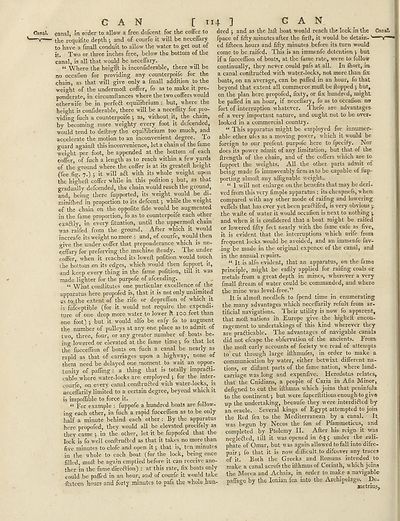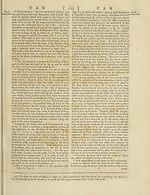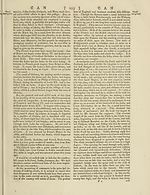Encyclopaedia Britannica, or, a Dictionary of arts, sciences, and miscellaneous literature : enlarged and improved. Illustrated with nearly six hundred engravings > Volume 5, BUR-CHI
(128) Page 114
Download files
Complete book:
Individual page:
Thumbnail gallery: Grid view | List view

CAN [ii
Canal, canal, in order to allow a free defcent for the coffer to
the requisite depth ; and of courfe it will be neceffary
to have a fmall conduit to allow the water to get out of
it. Two or three inches free, below the bottom of the
canal, is all that would be neceffary.
“ Where the height is inconfiderable, there will be
no occafion for providing any counterpoife for the
chain, as that will give only a fmall addition to the
weight of the undermoft coffer, fo as to make it pre¬
ponderate, in circumftances where the two coffers would
otherwife be in perfedl equilibrium : but, where the
height is confiderable, there will be a neceffity for pro¬
viding fuch a counterpoife 5 as, without it, the chain,
by becoming more weighty every foot it defeended,
would tend to deftroy the equilibrium too much, and
accelerate the motion to an inconvenient degree. To
guard againlt this inconvenience, let a chain of the fame
weight per foot, be appended at the bottom of each
coffer, of fuch a length as to reach within a few yards
of the ground where the coffer is at its greateft height
(fee fig. 7.) j it will a£t with its whole weight upon
the higheft coffer while in this pofition 5 but, as that
gradually defeended, the chain would reach the ground,
and, being there fupported, its weight would be di-
minifhed in proportion to its defcent 5 W'hile the weight
of the chain on the oppofite fide would be augmented
in the fame proportion, fo as to counterpoife each other
exaftly, in every fituation, until the uppermoft chain
was raifed from the ground. After which it would
increafe its weight no more : and, of courfe, would then
give the under coffer that preponderance which is ne¬
ceffary for preferving the machine Heady. The under
coffer, when it reached its loweft pofition v'ould touch
the bottom on its edges, which would then fupport it,
and keep every thing in the fame pofition, till it w as
made lighter for the purpofe of afeending.
“ What conftitutes one particular excellence of the
apparatus here propofed is, that it is not only unlimited
as to the extent of the rife or depreflion of which it
is fufceptible (for it would not require the expendi¬
ture of one drop more water to lower ?t 100 feet than
one foot) ; but it would alfo be eafy fo to augment
the number of pulleys at any one place as to admit of
two, three, four, or any greater number of boats be¬
ing lowered or elevated at the fame time} fo that let
the fucceffion of boats on fuch a canal be nearly as.
rapid as that of carriages upon a highway, none of
them need be delayed one moment to wait an oppor¬
tunity of paffing : a thing that is totally impra&i-
«able where water-locks are employed 5 for the inter-
courfe, on every canal conftrufted with water-locks, is
aeceffarily limited to a certain degree, beyond which it
is impoflible to force it.
“ For example : fuppofe a hundred boats are follow¬
ing each other, in fuch a rapid fucceffion as to be only
half a minute behind each other : By the apparatus
here propofed, they would all be elevated precifely as
they came •, in the other, let it be fuppofed that the
lock is fo well conftrutted as that it takes no more than
five minutes to elofe and open it •, that is, ten minutes
in the whole to each boat (for the. lock, being once
filled, muff be again emptied before it can receive ano¬
ther in the fame direftion) : at this rate, fix boats only
could be paffed in an hour, and1 of courfe it would take
fixteen hours and forty minutes to pafs the whole hun-
4 ] CAN
dred j and as the laff boat would reach the lock in the Canal*
fpace of fifty minutes after the firit, it would be detain- " v'"""
ed fifteen hours and fifty minutes before its turn would
come to be raifed. This is an immenfe detention j but
if a fucceffion of boats, at the fame rate,, were to follow
continually, they never could pafs at all. In ftiort, in
a canal conftrufted with water-locks, not more than fix
boats, on an average, can be paffed in an hour, fo that
beyond that extent all commerce muff be flopped ; but,
on the plan here propofed, fixty, or fix hundred, might
be paffed in an hour, if neceffarv, fo as to occafion no
fort of interruption whatever. Thefe are advantages
of a very important nature, and ought not to be over¬
looked in a commercial country.
“ This apparatus might be employed for innumer¬
able other ufes as a moving power, which it would be
foreign to our prefent purpofe here to fpecify. Nor
does its power admit of any limitation, but that of the
flrength of the chain, and of the coffers which are to
fupport the weights. All the other, parts admit of
being made fo immeveably firm as to be capable of lup
porting almoft any affignable weight..
“ I will not enlarge on the benefits that may be deri.
ved from this very fimple apparatus : its chcapnefs, when
compared with any other mode of raifing and lowering
veffels that has ever yet been practifed, is very obvious y
the waite of water it would occafion is next to nothing y
and when it is confidered that a boat might be raifed
or towered fifty feet nearly with the fame eafe as five,
it is evident that the interruptions which arife from
frequent locks would be avoided, and an immenfe fay¬
ing be made in the original expence of the canal, and
in the annual repairs.,
“ It is alfo evident, that an apparatus, on the fame
principle, might be eafily applied for raifing coals or
metals from a great depth in mines, wherever a very
fmall ftream of water could be commanded, and where
the mine was level-free.”
It is almoft needlefs to fpend time in enumerating
the many advantages which neceffarily refult from ar¬
tificial navigations. Their utility is now fo apparent,
that moft nations ih Europe give the higheft encou¬
ragement to undertakings of this kind wherever they
are practicable. The advantages of navigable canals
did not efcape the obfervation of the ancients. From
the moft early accounts of fociety we read of attempts
to' cut through large ifthmufes, in order to make a
communication by water, either betwixt different na¬
tions, or diftant parts of the fame nation, where land-
carriage w as long and expenfive. Herodotus relates,
that the Cnidians, a people of Caria in Afia Minor,
defigned to cut the ifthmus which joins that peninfula
to the continent ; but w'ere fuperftitious enough to giv©
up the undertaking, beeaufe they were interdifted. by
an oracle. Several kings of Egypt attempted to join
the Red fea to the Mediterranean by a canal. It
was begun by Necos the fon of Pfammetieus, and
completed by Ptolemy II. After his reign it was
neglefled, till it wras opened in 635 under the cali¬
phate of Omar, but w as again allowed to fall into difre-
pair •, fo that it is now difficult to difeover any traces
of it. Both the Greeks and Romans intended to
make a canal acrofs the ifthmus of Corinth, which joins
the Morea and Achaia, in order to make a navigable
paffage by the Ionian fea into the Archipelago. De-
aaetriuj^
Canal, canal, in order to allow a free defcent for the coffer to
the requisite depth ; and of courfe it will be neceffary
to have a fmall conduit to allow the water to get out of
it. Two or three inches free, below the bottom of the
canal, is all that would be neceffary.
“ Where the height is inconfiderable, there will be
no occafion for providing any counterpoife for the
chain, as that will give only a fmall addition to the
weight of the undermoft coffer, fo as to make it pre¬
ponderate, in circumftances where the two coffers would
otherwife be in perfedl equilibrium : but, where the
height is confiderable, there will be a neceffity for pro¬
viding fuch a counterpoife 5 as, without it, the chain,
by becoming more weighty every foot it defeended,
would tend to deftroy the equilibrium too much, and
accelerate the motion to an inconvenient degree. To
guard againlt this inconvenience, let a chain of the fame
weight per foot, be appended at the bottom of each
coffer, of fuch a length as to reach within a few yards
of the ground where the coffer is at its greateft height
(fee fig. 7.) j it will a£t with its whole weight upon
the higheft coffer while in this pofition 5 but, as that
gradually defeended, the chain would reach the ground,
and, being there fupported, its weight would be di-
minifhed in proportion to its defcent 5 W'hile the weight
of the chain on the oppofite fide would be augmented
in the fame proportion, fo as to counterpoife each other
exaftly, in every fituation, until the uppermoft chain
was raifed from the ground. After which it would
increafe its weight no more : and, of courfe, would then
give the under coffer that preponderance which is ne¬
ceffary for preferving the machine Heady. The under
coffer, when it reached its loweft pofition v'ould touch
the bottom on its edges, which would then fupport it,
and keep every thing in the fame pofition, till it w as
made lighter for the purpofe of afeending.
“ What conftitutes one particular excellence of the
apparatus here propofed is, that it is not only unlimited
as to the extent of the rife or depreflion of which it
is fufceptible (for it would not require the expendi¬
ture of one drop more water to lower ?t 100 feet than
one foot) ; but it would alfo be eafy fo to augment
the number of pulleys at any one place as to admit of
two, three, four, or any greater number of boats be¬
ing lowered or elevated at the fame time} fo that let
the fucceffion of boats on fuch a canal be nearly as.
rapid as that of carriages upon a highway, none of
them need be delayed one moment to wait an oppor¬
tunity of paffing : a thing that is totally impra&i-
«able where water-locks are employed 5 for the inter-
courfe, on every canal conftrufted with water-locks, is
aeceffarily limited to a certain degree, beyond which it
is impoflible to force it.
“ For example : fuppofe a hundred boats are follow¬
ing each other, in fuch a rapid fucceffion as to be only
half a minute behind each other : By the apparatus
here propofed, they would all be elevated precifely as
they came •, in the other, let it be fuppofed that the
lock is fo well conftrutted as that it takes no more than
five minutes to elofe and open it •, that is, ten minutes
in the whole to each boat (for the. lock, being once
filled, muff be again emptied before it can receive ano¬
ther in the fame direftion) : at this rate, fix boats only
could be paffed in an hour, and1 of courfe it would take
fixteen hours and forty minutes to pafs the whole hun-
4 ] CAN
dred j and as the laff boat would reach the lock in the Canal*
fpace of fifty minutes after the firit, it would be detain- " v'"""
ed fifteen hours and fifty minutes before its turn would
come to be raifed. This is an immenfe detention j but
if a fucceffion of boats, at the fame rate,, were to follow
continually, they never could pafs at all. In ftiort, in
a canal conftrufted with water-locks, not more than fix
boats, on an average, can be paffed in an hour, fo that
beyond that extent all commerce muff be flopped ; but,
on the plan here propofed, fixty, or fix hundred, might
be paffed in an hour, if neceffarv, fo as to occafion no
fort of interruption whatever. Thefe are advantages
of a very important nature, and ought not to be over¬
looked in a commercial country.
“ This apparatus might be employed for innumer¬
able other ufes as a moving power, which it would be
foreign to our prefent purpofe here to fpecify. Nor
does its power admit of any limitation, but that of the
flrength of the chain, and of the coffers which are to
fupport the weights. All the other, parts admit of
being made fo immeveably firm as to be capable of lup
porting almoft any affignable weight..
“ I will not enlarge on the benefits that may be deri.
ved from this very fimple apparatus : its chcapnefs, when
compared with any other mode of raifing and lowering
veffels that has ever yet been practifed, is very obvious y
the waite of water it would occafion is next to nothing y
and when it is confidered that a boat might be raifed
or towered fifty feet nearly with the fame eafe as five,
it is evident that the interruptions which arife from
frequent locks would be avoided, and an immenfe fay¬
ing be made in the original expence of the canal, and
in the annual repairs.,
“ It is alfo evident, that an apparatus, on the fame
principle, might be eafily applied for raifing coals or
metals from a great depth in mines, wherever a very
fmall ftream of water could be commanded, and where
the mine was level-free.”
It is almoft needlefs to fpend time in enumerating
the many advantages which neceffarily refult from ar¬
tificial navigations. Their utility is now fo apparent,
that moft nations ih Europe give the higheft encou¬
ragement to undertakings of this kind wherever they
are practicable. The advantages of navigable canals
did not efcape the obfervation of the ancients. From
the moft early accounts of fociety we read of attempts
to' cut through large ifthmufes, in order to make a
communication by water, either betwixt different na¬
tions, or diftant parts of the fame nation, where land-
carriage w as long and expenfive. Herodotus relates,
that the Cnidians, a people of Caria in Afia Minor,
defigned to cut the ifthmus which joins that peninfula
to the continent ; but w'ere fuperftitious enough to giv©
up the undertaking, beeaufe they were interdifted. by
an oracle. Several kings of Egypt attempted to join
the Red fea to the Mediterranean by a canal. It
was begun by Necos the fon of Pfammetieus, and
completed by Ptolemy II. After his reign it was
neglefled, till it wras opened in 635 under the cali¬
phate of Omar, but w as again allowed to fall into difre-
pair •, fo that it is now difficult to difeover any traces
of it. Both the Greeks and Romans intended to
make a canal acrofs the ifthmus of Corinth, which joins
the Morea and Achaia, in order to make a navigable
paffage by the Ionian fea into the Archipelago. De-
aaetriuj^
Set display mode to:
![]() Universal Viewer |
Universal Viewer | ![]() Mirador |
Large image | Transcription
Mirador |
Large image | Transcription
Images and transcriptions on this page, including medium image downloads, may be used under the Creative Commons Attribution 4.0 International Licence unless otherwise stated. ![]()
| Permanent URL | https://digital.nls.uk/192985933 |
|---|
| Attribution and copyright: |
|
|---|
| Description | Ten editions of 'Encyclopaedia Britannica', issued from 1768-1903, in 231 volumes. Originally issued in 100 weekly parts (3 volumes) between 1768 and 1771 by publishers: Colin Macfarquhar and Andrew Bell (Edinburgh); editor: William Smellie: engraver: Andrew Bell. Expanded editions in the 19th century featured more volumes and contributions from leading experts in their fields. Managed and published in Edinburgh up to the 9th edition (25 volumes, from 1875-1889); the 10th edition (1902-1903) re-issued the 9th edition, with 11 supplementary volumes. |
|---|---|
| Additional NLS resources: |
|

